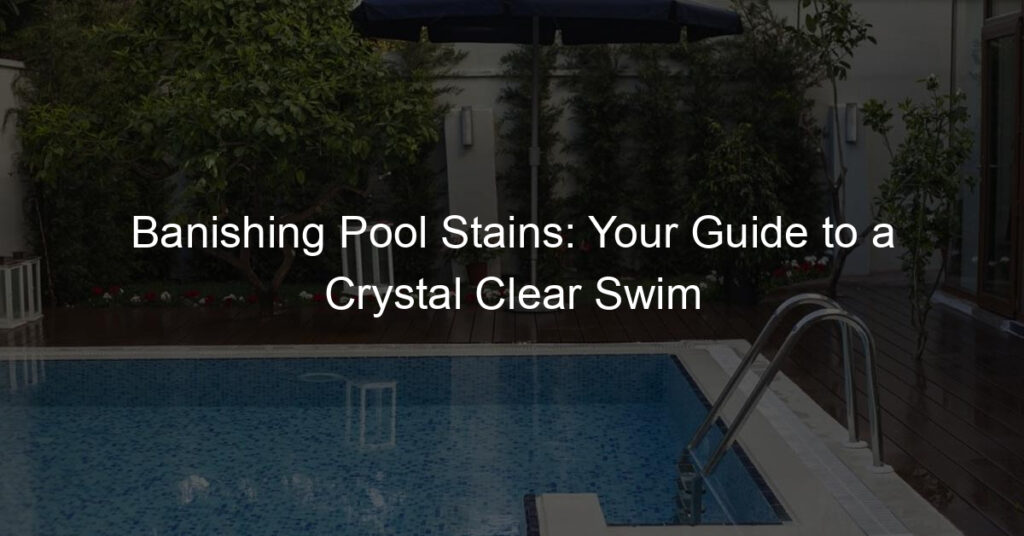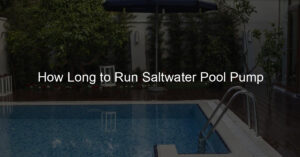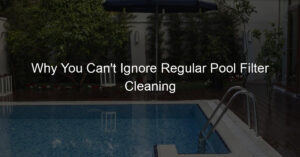Introduction to Pool Maintenance
Having a swimming pool at home is a luxury that many people enjoy. But, it also comes with a responsibility – pool maintenance. A well-maintained pool is not only beautiful to look at, but it also ensures the health and safety of those who use it.
- The Importance of Regular Pool Maintenance
Regular pool maintenance is crucial for several reasons. First, it helps to keep the water clean and clear. No one wants to swim in a pool with dirty, cloudy water. Second, regular maintenance can prevent potential problems from becoming major issues. For example, if you notice a small crack in the pool’s surface during your routine maintenance, you can repair it before it becomes a larger, more costly problem. Third, maintaining your pool can extend its lifespan, saving you money in the long run.
- Common Pool Maintenance Tips
Here are some common pool maintenance tips that can help you keep your pool in top shape:
- Check the pool’s chemistry: This should be done at least twice a week during the summer and once a week during the winter. The pH level should be between 7.2 and 7.8.
- Clean the skimmer basket: The skimmer basket should be cleaned out weekly, or as needed. This will help to improve the pool’s circulation and lower the amount of chlorine you’ll need.
- Brush the pool: The walls and tiles of the pool should be brushed every week to prevent algae buildup.
- Vacuum the pool: Vacuuming the pool every week will help to keep the water clear and reduce the amount of chemicals you need to add.
- Check the water level: The water should not be too high or too low. The right level is usually halfway up the opening of your pool skimmer.
Remember, a well-maintained pool is not only more enjoyable to swim in, but it also saves you time and money in the long run. So, make pool maintenance a regular part of your routine.
Understanding Pool Discoloration
Pool discoloration can be a common issue for pool owners. It’s important to understand what causes these changes in color, so you can take the right steps to restore your pool’s natural beauty. Let’s dive into the main causes of pool discoloration.
Causes of Pool Discoloration
There are several factors that can cause your pool water to change color. Here are the top three:
-
- Algae Growth: Algae are tiny plants that can grow in your pool if the conditions are right. They can turn your pool water green, yellow, or even black. Algae growth is often a sign that your pool’s chlorine levels are too low.
Algae can multiply quickly, especially in warm, sunny weather. If left untreated, they can make your pool water cloudy and leave a slimy residue on the pool walls and floor.
-
- Chemical Imbalance: Your pool water needs to have the right balance of chemicals to stay clear and safe. If the water’s pH, alkalinity, or sanitizer levels are off, it can cause discoloration. For example, high levels of chlorine can turn pool water cloudy or give it a greenish tint.
It’s important to test your pool water regularly and adjust the chemicals as needed. This can help prevent discoloration and other problems.
-
- Mineral Deposits: Minerals like iron, copper, and calcium can cause stains and discoloration in your pool. For instance, iron can turn your pool water a rusty red color, while copper can make it look green.
These minerals can get into your pool water in several ways. They might be in the fill water, or they could come from metal pool equipment that’s corroding. If you notice mineral stains, it’s a good idea to test your pool water and treat it with a metal sequestrant.
Understanding the causes of pool discoloration is the first step to fixing the problem. In the next sections, we’ll discuss how to remove pool stains and prevent discoloration.
Common Pool Stains
When maintaining your swimming pool, you may encounter a few common types of stains. Let’s explore these stains and learn more about them.
-
- Metal Stains
Metal stains are often caused by metals like iron, copper, and manganese that are present in the water. These stains can appear as green, brown, or black spots on the pool surface. For example, if your pool has a greenish tint, it might be due to high iron content in the water. These stains can be removed using specific metal stain removers available in the market.
-
- Organic Stains
Organic stains are caused by organic materials such as leaves, grass, or even small critters that fall into the pool. These materials can leave behind brown or green stains. A simple way to prevent these stains is to regularly skim your pool and remove any organic debris. Organic stains can be treated with shock treatment and proper brushing.
-
- Calcium Scale Stains
Calcium scale stains are white, crusty deposits that form on the pool surfaces. They are caused by high levels of calcium hardness in the pool water. These stains can be quite stubborn, but they can be removed with a pumice stone or a scale remover. To prevent calcium scale stains, it’s important to regularly test and adjust the calcium hardness level of your pool water.
Understanding these common pool stains is the first step towards maintaining a clean and clear pool. Remember, prevention is always better than cure. Regular pool maintenance can help prevent these stains and keep your pool looking its best.
Removing Pool Stains
Swimming pool stains can be a real eyesore. They can make your pool look dirty and uninviting. But don’t worry! There are many products available that can help you remove these stains and get your pool looking sparkling clean again.
Pool Stain Removal Products
When it comes to removing pool stains, there are three main types of products you can use. Each one works in a slightly different way and is best suited to dealing with certain types of stains.
- Chlorine-based products: These are the most commonly used products for pool stain removal. They work by breaking down the stain into smaller particles, which can then be easily removed. Chlorine-based products are particularly effective at dealing with organic stains, such as those caused by leaves, grass, and algae.
- Enzyme-based products: These products use natural enzymes to break down stains. They are a great choice if you want to use a more environmentally friendly product. Enzyme-based products are excellent at dealing with oil-based stains, such as those caused by sunscreen and body oils.
- Acid-based products: These products use acid to dissolve stains. They are very powerful and should be used with caution. Acid-based products are best suited to dealing with mineral stains, such as those caused by iron and copper.
Remember, it’s important to choose the right product for the type of stain you are dealing with. If you’re not sure, it’s always a good idea to seek advice from a pool maintenance professional.
Pool Cleaning Techniques
Keeping your pool clean is an essential part of pool maintenance. There are several methods you can use to clean your pool, and each has its own benefits. Let’s explore three popular pool cleaning techniques: manual scrubbing, pressure washing, and chemical treatment.
-
- Manual Scrubbing
Manual scrubbing is the most basic and traditional method of cleaning a pool. It involves using a pool brush to scrub the sides and bottom of the pool. This method is effective in removing dirt, algae, and minor stains. It’s a good idea to scrub your pool at least once a week to prevent build-up.
-
- Pressure Washing
Pressure washing is a more advanced cleaning technique. It uses a high-pressure water jet to blast away dirt and grime. This method is particularly effective for cleaning large areas quickly and removing stubborn stains. However, it’s important to use this method carefully to avoid damaging your pool’s surface.
-
- Chemical Treatment
Chemical treatment involves using specific chemicals to clean and sanitize your pool. The most common chemicals used are chlorine and bromine. These chemicals kill bacteria and other harmful microorganisms, ensuring your pool is safe for swimming. It’s important to monitor your pool’s chemical levels regularly to maintain a healthy balance.
In conclusion, manual scrubbing, pressure washing, and chemical treatment are all effective methods for cleaning your pool. The best method for you will depend on your pool’s condition, your budget, and how much time you can dedicate to pool maintenance. Remember, a clean pool is not only more enjoyable to swim in, but it also lasts longer and is safer for your health.
Preventing Pool Discoloration
Preventing pool discoloration is easier than you may think. With a few simple steps, you can keep your pool looking crystal clear and inviting all year round. Let’s dive into the three key methods to prevent pool discoloration: regular pool cleaning, maintaining chemical balance, and using pool covers.
- Regular Pool Cleaning
Regular pool cleaning is the first step to prevent pool discoloration. It’s like brushing your teeth – if you do it regularly, you can prevent problems before they start. Make sure to skim the pool surface daily to remove leaves and other debris. Vacuum the pool floor and brush the walls and tile line weekly. This will help to prevent algae growth, which can cause your pool to turn green.
- Maintaining Chemical Balance
Maintaining the right chemical balance in your pool is crucial to prevent discoloration. The pH level, which measures how acidic or basic the water is, should be between 7.2 and 7.8. If the pH level is too high, it can cause calcium deposits, which can turn your pool cloudy or even green. If it’s too low, it can cause the pool to become corrosive and damage the pool equipment. Regularly testing the water and adjusting the chemicals as needed can help to keep the water crystal clear.
- Using Pool Covers
Using a pool cover is another effective way to prevent pool discoloration. A pool cover can help to keep out debris, reduce evaporation, and keep the water temperature stable. This can help to prevent algae growth and keep the water clear. Plus, using a pool cover can also help to save on water and energy costs.
In conclusion, preventing pool discoloration is all about regular maintenance. By cleaning your pool regularly, maintaining the right chemical balance, and using a pool cover, you can keep your pool looking its best. Happy swimming!
Dealing with Pool Stains
Pool stains can be a real nuisance, but don’t worry! With the right knowledge and tools, you can tackle them effectively. Let’s dive into a case study to understand how to deal with stubborn pool stains.
Case Study: Removing Stubborn Pool Stains
Let’s consider the case of Mr. Johnson, a pool owner who successfully removed stubborn stains from his pool. He followed a systematic approach, which we will discuss in detail.
-
- Identifying the Stain
Mr. Johnson first identified the type of stain. It was a greenish-brown stain, indicating a mix of algae and metal stains. Identifying the stain is crucial as it helps in choosing the right treatment.
-
- Choosing the Right Treatment
Based on the stain type, Mr. Johnson chose a treatment that was a combination of algaecide and a metal sequestrant. Remember, choosing the right treatment is vital for effective stain removal.
-
- Applying the Treatment
Mr. Johnson then applied the treatment to his pool. He followed the instructions on the product labels for the correct application. It’s important to apply the treatment properly for the best results.
-
- Evaluating the Results
After applying the treatment, Mr. Johnson monitored his pool closely. Within a week, the stains started to fade. By the end of the month, his pool was stain-free. Evaluating the results helps in understanding the effectiveness of the treatment and whether any adjustments are needed.
In conclusion, dealing with pool stains involves identifying the stain, choosing the right treatment, applying the treatment, and evaluating the results. By following these steps, you too can have a clean and stain-free pool.
| Steps | Description |
|---|---|
| Identifying the Stain | Determine the type of stain based on its color and appearance. |
| Choosing the Right Treatment | Select a treatment based on the identified stain type. |
| Applying the Treatment | Apply the treatment following the instructions on the product label. |
| Evaluating the Results | Monitor the pool to assess the effectiveness of the treatment. |
Swimming Pool Discoloration Remedies
Are you tired of seeing your swimming pool lose its sparkling blue color? Don’t worry, you’re not alone. Many pool owners face this issue. But the good news is, there are several effective remedies for pool discoloration. Let’s explore them.
-
- Using Stain Removers
Stain removers are a popular solution for pool discoloration. These products are designed to break down and eliminate stains caused by minerals like iron and copper. For example, a pool owner in Florida managed to restore his pool’s color by using a stain remover. He applied the product according to the instructions and within a week, the discoloration was gone. Remember, it’s crucial to follow the product’s instructions for the best results.
-
- Applying Stain Prevention Products
Prevention is always better than cure. This saying holds true even for pool discoloration. Stain prevention products work by forming a protective layer on the pool’s surface, preventing minerals from staining it. A case study in California showed that a pool maintained with a stain prevention product remained stain-free for over a year. So, consider using these products as part of your regular pool maintenance routine.
-
- Seeking Professional Help
If you’ve tried everything and the discoloration persists, it might be time to seek professional help. Pool maintenance professionals have the knowledge and tools to handle stubborn stains. They can also provide valuable advice on preventing future discoloration. For instance, a pool owner in Texas hired a professional after struggling with discoloration for months. The professional was able to identify the cause of the stains and provide a long-term solution.
In conclusion, dealing with pool discoloration can be a challenge. But with the right stain remover, prevention products, and professional help, you can restore your pool’s color and enjoy a crystal clear swim.
| Remedy | Effectiveness |
|---|---|
| Stain Removers | Highly effective for removing existing stains |
| Stain Prevention Products | Useful for preventing future stains |
| Professional Help | Recommended for stubborn stains and long-term solutions |
Conclusion: Enjoying a Crystal Clear Swim
After understanding the intricacies of pool maintenance, stain removal, and discoloration prevention, it’s time to dive into the joy of a crystal clear swim. Let’s summarize the key takeaways and share some final thoughts on maintaining your pool’s pristine condition.
- Key takeaways on pool maintenance and stain removal
Regular pool maintenance is the cornerstone of a clean and healthy swimming environment. It involves:
- Regularly checking and adjusting the pool’s chemical balance.
- Keeping the pool clean by removing debris and scrubbing the pool walls and floor.
- Properly operating and maintaining the pool’s filtration system.
Stain removal is another crucial aspect of pool maintenance. Remember:
- Identify the type of stain before choosing a removal method.
- Non-organic stains can often be removed with a stain remover or by adjusting the pool’s chemistry.
- Organic stains usually require shock treatment and scrubbing.
- Final thoughts on preventing pool discoloration
Preventing pool discoloration is easier than dealing with it after it has occurred. Here are some final thoughts:
- Regular maintenance and cleaning are the best ways to prevent discoloration.
- Monitor your pool’s chemistry closely and adjust as needed.
- Use a pool cover to protect your pool from debris and sunlight, which can cause discoloration.
In conclusion, maintaining a crystal clear pool is not a daunting task if you follow the right steps. With regular maintenance, stain removal, and discoloration prevention, you can enjoy a clean and inviting pool all season long.














